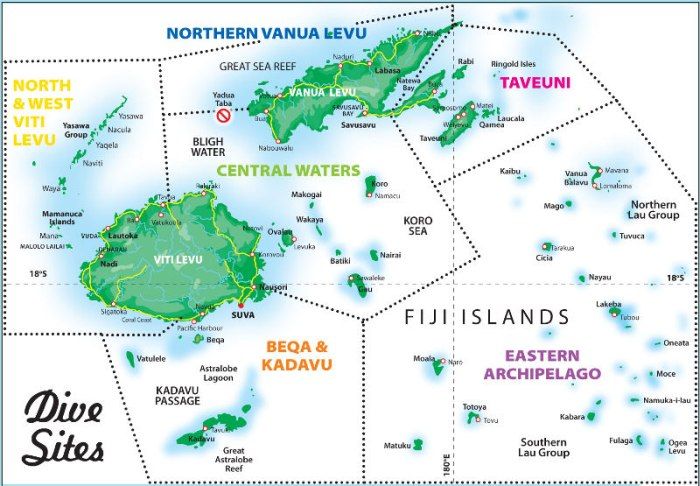The title of the video, Dakuwaqa's Garden, refers to a god from Fijian mythology, more precisely the Shark-God. Fishermen worshipped him because he protected them at sea. Normally, you should see, in the lower right corner, fourth from the right, the CC button. If you press it you can find where the footage was shot and/or what species were being filmed at the time.
Fiji is an island state consisting of over 332 islands in Melanesia in the South Pacific, around 2,000 kilometers northeast of New Zealand. To the west is Vanuatu to the west, New Caledonia is to the southwest, Tonga is to the east, the Samoas and France's Wallis and Futuna to the northeast, and Tuvalu is to the north.
Of those 332 islands islands, only 110 are permanently inhabited, and 87 per cent of Fiji's population of around 860,000 love on the two main islands, Viti Levu and Vanua Levu. Suva, the capital and largest city, is on Viti Levu. Smaller urban centres are Nadi (tourism) or Lautoka (sugar cane industry).
Fiji boasts one of the most developed economies in the Pacific due to prodigious natural resources (forests, minerals, fish). Currently its main sources of income are tourism and sugar exports.
In case that, after having watched this video, you'd like to go there as well, here's a handy map with dive sites:

Marine ecologist and dive instructor Helen Sykes has some info on what to look for where:
a.) North & West of Viti Levu
The Coral Coast, Mamanuca & Yasawa Islands
The best for casual and relatively new divers: easy diving, very few currents, schools of small colourful fish, most sites are relatively shallow (best diving generally in less than 50 feet/ 15 metres of water).
b.) The Bigger Small Islands
Recommended for the more experienced divers who can handle currents and deeper diving at least some of the time: spectacular soft corals, pristine reef systems, and larger fish life.
Taveuni for soft corals, swarming fish, rare critters, and intact ecosystems.
Beqa for soft corals, rare critters, wrecks and shark feeding.
Kadavu for walls and passages, healthy hard corals, manta rays and sharks.
Coral & crinoids by Cat Halloway
Coral & crinoids by Cat Halloway
c.) Central Waters
Some of the best and most varied diving in Fiji – most of these sites are quite far off shore. Mostly easy diving but many sites require careful planning due to tide dependent currents and depth.
Vatu-i-Ra Passage for spectacular walls, soft corals, schooling fish. Lomaiviti islands for passages with sharks, manta rays, and rare critters.
Southern Vanua Levu for walls and soft corals. Namena for absolutely everything concentrated into one package.
d.) Northern Vanua Levu
Cakaulevu (The Great Sea Reef –the third longest barrier reef in the world!)
Dramatic outer walls and passages.
Limited fish life in some areas, and outer waters can be rough. Inner reef mangrove islands have poor visibility but extensive fish life of interest to specialists and ecologists. Kia Island provides a good and sheltered bay to base while exploring.
e.) The Eastern Archipelago
Lau Islands: scattered islands with varied diving. Relatively easy conditions, but there are fewer well-known dive sites, so most is exploratory diving with some areas better than others.
Hat tip my oldest sister H.
MFBB.